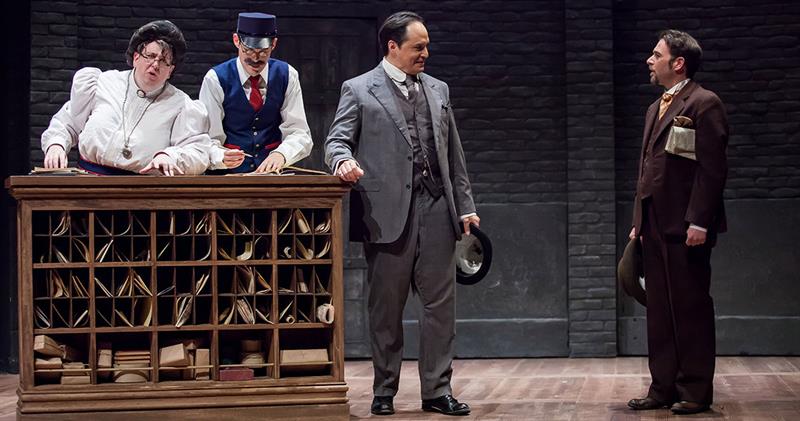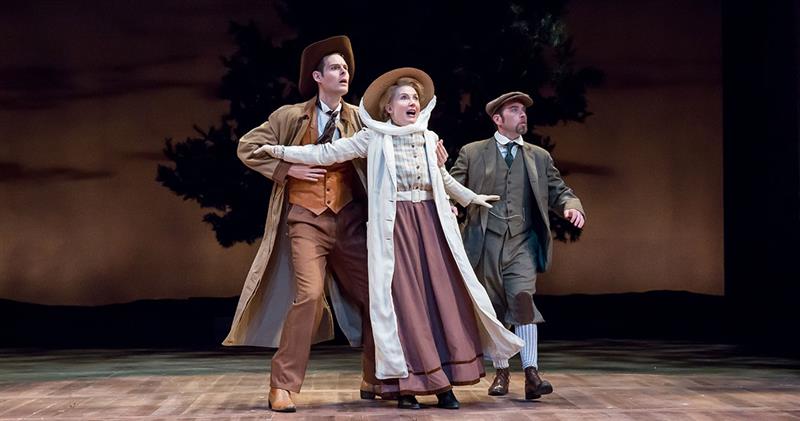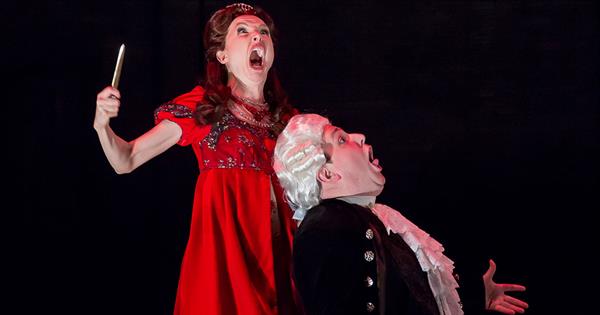Follow a Trail of Clues to Baskerville Hall
June 13, 2017

The world of Sherlock Holmes and Dr. Watson has been a beloved one for generations, and it comes to life at the Playhouse with Ken Ludwig’s Baskerville: A Sherlock Holmes Mystery. In this classic mystery, the gloomy and foreboding world of fog, quicksand, moors and monsters combine to create a dizzying web of clues. Holmes and Watson must unravel them quickly if they hope to save the latest heir to the Baskerville fortune from a centuries-old curse.
Are you ready to take on the case of Baskerville Hall? Here are some notes on production elements that we’ve prepared for you to begin the investigation.

With a foundation rooted not in reason but folklore, the Baskerville curse seems especially difficult to crack. Will these supernatural stories affect the Holmes’s investigation of yet another Baskerville murder?

The moors (or rather, the moorlands) of England carry with them a rather Gothic image. In Baskerville, they emphasize the eerie nature of the estate and create a sense of danger that lurks around every corner. Conan Doyle was not the first to use such a backdrop for classic, Gothic tales. Emily Brontë’s Wuthering Heights relies heavily on the foreboding terrain to emphasize the dark romance of the story. Thomas Hardy’s Tess of the d'Urbervilles and Frances Hodgson Burnett’s The Secret Garden make similar symbolic use of the moorlands as well. Each of these stories describes the environment as foggy, windswept, dark and mysterious. The land is untamed, uninhabited and riddled with peril.
It’s no wonder, then, that Hound of the Baskervilles is based in the moorlands. The grounds pose many threats to the investigation in their promise of spooky surprises.
Master storytellers like Conan Doyle knew the reader would be tracking clues along with the protagonist and relied on these misdirects to keep them reading until the very last page. Baskerville is no exception. The show features a slew of characters who may or may not be as deceptive as they seem, complicating an already tricky web of clues.

“Classical theatre has always been filled with doubling and tripling, and it is often a source of theatrical joy,” playwright Ken Ludwig says in an interview about the show. “Shakespeare’s company had between 12 and 15 actors in it, but his plays contain as many as 25-35 characters.”
Baskerville makes creative use out of doubling and delights in throwing the audience off the scent as to who the suspects may be and what their motives truly are. When one actor embodies the lives of many, it can pose an additional challenge in the investigation.
Follow the trail of clues of the haunting world of Baskerville, from April 22 to May 20. To learn more, visit the production detail page.
Are you ready to take on the case of Baskerville Hall? Here are some notes on production elements that we’ve prepared for you to begin the investigation.

Hound of the Baskervilles
Ken Ludwig’s Baskerville is an adaptation of the 1901 novel Hound of the Baskervilles written by Sir Arthur Conan Doyle. Sir Charles Baskerville—heir to an estate that’s plagued by legendary curses—is found dead at the family’s English moorland home. Holmes and Watson, brought on to investigate, quickly learn that the estate is plagued by an old curse. Haunting tales of madness, murder and a monstrous black hound have swirled throughout local history, creating a legacy chock full of sinister events. In the wake of Sir Charles’s death, the Baskerville next-of-kin arrives—a fish-out-of-water American from Texas—to take over the estate and inheritance. Yet the family fortune is threatened not only by its legendary curses but a dossier full of suspicious characters whose motives can’t be trusted.The Baskerville Curse
The heart of Conan Doyle’s mystery is based on the fictional Baskerville family curse. In the story, Baskerville Hall sees generations of curses and misfortune that stem from the cruelty of Hugo Baskerville. Rumors of his wicked behavior inflicted on certain townsfolk were the talk of the moorland village, and over time, they became material for horrifying stories about the estate. These nightmarish tales echo throughout the rest of the play as a constant reminder of an unstoppable curse. The passage of time has allowed for more incredulous details to be woven into the narrative, creating a devilish allure in its wake.With a foundation rooted not in reason but folklore, the Baskerville curse seems especially difficult to crack. Will these supernatural stories affect the Holmes’s investigation of yet another Baskerville murder?

The Moors
Stepping into the surroundings of the Baskerville estate, Doctor Watson says ominously, “We proceeded through the moors of Devonshire, a landscape of such desolation and despair that we may as well have been visiting another, darker planet where the limbs, the trunk, the very heart of Nature were filled with malevolence. My heart grieved for the world around me; and then I saw it, in its dark, forbidding glory: Baskerville Hall.”The moors (or rather, the moorlands) of England carry with them a rather Gothic image. In Baskerville, they emphasize the eerie nature of the estate and create a sense of danger that lurks around every corner. Conan Doyle was not the first to use such a backdrop for classic, Gothic tales. Emily Brontë’s Wuthering Heights relies heavily on the foreboding terrain to emphasize the dark romance of the story. Thomas Hardy’s Tess of the d'Urbervilles and Frances Hodgson Burnett’s The Secret Garden make similar symbolic use of the moorlands as well. Each of these stories describes the environment as foggy, windswept, dark and mysterious. The land is untamed, uninhabited and riddled with peril.
It’s no wonder, then, that Hound of the Baskervilles is based in the moorlands. The grounds pose many threats to the investigation in their promise of spooky surprises.
Red Herring
Known also as “ignorance of refutation,” a red herring is a logical fallacy that uses a subject or object to purposefully mislead and distract from an otherwise important issue. In literature and film, the storyteller will toss in a red herring to intentionally lead characters, readers and viewers off the trail. The trick, though, is that the red herring is never seen as one until it’s revealed to be a distraction.Master storytellers like Conan Doyle knew the reader would be tracking clues along with the protagonist and relied on these misdirects to keep them reading until the very last page. Baskerville is no exception. The show features a slew of characters who may or may not be as deceptive as they seem, complicating an already tricky web of clues.

Actor Doubling
One of theatre’s many traditions includes doubling, in which one actor performs two (or more) roles in the same production and performance. Doubling is often born out of financial necessity, yet in this case, it’s been embraced for artistic reasons. In Baskerville, three actors take on dozens of roles each.“Classical theatre has always been filled with doubling and tripling, and it is often a source of theatrical joy,” playwright Ken Ludwig says in an interview about the show. “Shakespeare’s company had between 12 and 15 actors in it, but his plays contain as many as 25-35 characters.”
Baskerville makes creative use out of doubling and delights in throwing the audience off the scent as to who the suspects may be and what their motives truly are. When one actor embodies the lives of many, it can pose an additional challenge in the investigation.
Follow the trail of clues of the haunting world of Baskerville, from April 22 to May 20. To learn more, visit the production detail page.